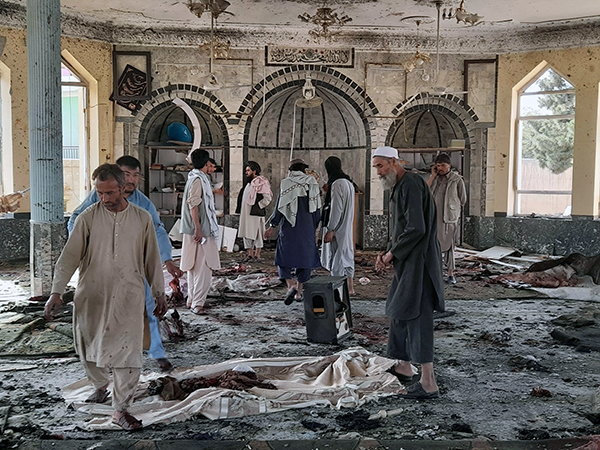The Taliban promised the United States to keep the extremist group in check during successive rounds of peace talks. Under the 2020 US-Taliban accord, the Taliban guaranteed that Afghanistan would not become a haven for terrorist groups threatening the US or its allies. But it is unclear if they can keep their pledge.
With the Taliban in power in Afghanistan, the Islamic State (IS) group has threatened to usher in another violent phase. There has been a sudden uptick in IS attacks since the Taliban takeover on 15 August.
Two deadly bombings have hit Kabul. One was outside the airport at the height of evacuations before the U.S. exit that killed 169 Afghans and 13 U.S. service members. Another deadly bombing, on 8 October, in the northern province of Kunduz killed 46 worshippers inside a mosque frequented by Shiites. The Islamic State-Khorasan (IS-K), the Afghanistan-based arm of the terrorist organisation, has claimed responsibility. Earlier, on October 3, a bomb targeted a memorial service being held for the mother of the Taliban spokesman, Zabihullah Mujahid, in a Kabul mosque, killing five. All these attacks suggest that the IS-K’s ability to strike has grown. Other deadly IS attacks have struck in the capital, Kabul, and provinces to the east and north, while smaller-scale attacks target Taliban fighters almost daily.
Now that the US and the international presence is mostly gone, the IS was going after the state, which is now the Taliban.
Hatred Towards Shiias
The IS’s doctrinal hatred towards the Shias is known. In Iraq and Syria, it systematically targeted Shias, who it calls “rejectionists” of faith, and used such attacks to mobilise the support of Sunni hardliners and trigger sectarian conflicts.
Long Rivalry
Both the Taliban and IS advocate rule by their radical interpretations of Islamic law. But there are key ideological differences that fuel their hatred of each other. The Taliban say they are creating an Islamic state in Afghanistan, within the borders of that country. The Taliban downplay IS’s capabilities and dismiss them as a fringe group with no mainstream appeal.
IS says it is the Islamic State, a global caliphate that it insists all Muslims must support. It is contemptuous of the Taliban’s nationalist goals and doesn’t recognize them as a pure Islamic movement. For similar reasons, IS has long been a staunch enemy of al-Qaida.
Both the Taliban and IS advocate particularly harsh versions of Islamic Shariah law and have used tactics like suicide bombers. But when it ruled territory in Syria and Iraq, IS was even more brutal and carried out more horrific punishments than the Taliban did.
IS emerged in Afghanistan in 2015 with the name Islamic State in Khorasan Province, at a time when the group was at its peak, controlling much of Iraq and Syria. It drew members from Afghan and Pakistani militants, including a wave of Taliban defectors.
The group initially found support among Afghanistan’s small Salafist movement in eastern Kunar and Nangarhar provinces. The Salafis had largely been marginalized by the Taliban, and by connecting with the rising IS, the Salafist movement found a means to establish military strength.
But IS’s brutal ways have since led some Salafi clerics to voice opposition. In the years after its emergence, IS was badly hurt by military setbacks at the hands of the Taliban and by U.S. airstrikes, before surging again the past year.
End Game
The IS’s immediate aim is to destabilize the Taliban and shatter the group’s image as a guardian of security.
For now, its strategy is slow and methodical. It is reaching out to tribes and other groups to recruit from their ranks while stamping out dissent among moderate Salafis and carrying out jailbreaks, assassinations, and attacks on Taliban personnel.
The Taliban are also strong and can uproot IS on their own, even without the backup of U.S. airstrikes that nearly eliminated IS. The IS — unlike the Taliban during their insurgency — do not have access to safe havens in Pakistan and Iran.
The Taliban have rejected cooperating with the U.S. against IS.
IS’s future trajectory in Afghanistan will depend largely on its ability to recruit more members and win over large segments of the population. Since their inception, they have been poaching Taliban members.
Comments
While both groups have used tactics of terror, the IS-K is a pan-Islamist jihadist outfit, while the Taliban are largely a Pashtun nationalist militancy. The rise of the IS-K poses multiple challenges to the Taliban’s rule over Afghanistan, which many in Afghanistan and Pakistan saw as a solution to the country’s security woes. On one side, their promise to provide security looks hollow. Afghanistan’s cities under the Taliban remain as insecure as they were under the previous Islamic Republic. On the other hand, even if the Taliban, under pressure from Afghanistan’s donors and the public, want to make some concessions on the many restrictions already imposed, they would come under pressure from the more extremist IS-K, which says the Taliban are not Islamic enough. For the people of Afghanistan, who are stuck between the devil and the deep blue sea, the war that started 40 years ago continues, no matter who is in power in Kabul.













